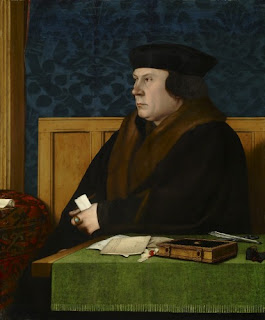 |
| Follower of Jan Van Scorel. oil on panel.1535 |
 | |
| Mark Rylance as Cromwell in BBC TV adaptation of Hilary Mantel's novel Wolf Hall |
 |
| Portrait of Thomas Cromwell. Hans Holbein Oil and tempera on oak panel, 781 mm x 619 mm, National Portrait Gallery, London |
 Finished framing in a period style black molded Dutch frame a self-portrait in the style of a follower of Jan Van Scorel from 1535. (The original is in the National Gallery in London.) Over the mantelpiece in Bruges it makes me roughly the same age as the older bits of the house. Apart from playfully imagining a high social status as a Renaissance gentleman, with Roman intaglio signet ring (rather like the portrait of Thomas Cromwell which Mark Rylance recreates from Hans Holbein's original), as a portrait in the 'vanitas' or 'memento mori' tradition it contains both Christian contemplative and classical stoic philosophical references as well which can be read in both the skull and flower. The allusion to the natural cycles of death and regeneration, metamorphoses and transformation is continued in the trompe l' oeil butterfly on the ledge at the bottom of the painting which alludes to Chinese philosopher Zhuangzi or Chuang Chou's famous statement.
Finished framing in a period style black molded Dutch frame a self-portrait in the style of a follower of Jan Van Scorel from 1535. (The original is in the National Gallery in London.) Over the mantelpiece in Bruges it makes me roughly the same age as the older bits of the house. Apart from playfully imagining a high social status as a Renaissance gentleman, with Roman intaglio signet ring (rather like the portrait of Thomas Cromwell which Mark Rylance recreates from Hans Holbein's original), as a portrait in the 'vanitas' or 'memento mori' tradition it contains both Christian contemplative and classical stoic philosophical references as well which can be read in both the skull and flower. The allusion to the natural cycles of death and regeneration, metamorphoses and transformation is continued in the trompe l' oeil butterfly on the ledge at the bottom of the painting which alludes to Chinese philosopher Zhuangzi or Chuang Chou's famous statement.
Once upon a time, I Chuang Chou dreamt I was a butterfly, fluttering hither and thither, to all intents and purposes a butterfly. I was conscious only of my happiness as a butterfly, unaware that I was Chou. Soon I awakened, and there I was, veritably myself again. Now I do not know whether I was then a man dreaming I was a butterfly, or whether I am now a butterfly, dreaming I am a man. Between man and butterlfy is necessarily a distinction. The transition is called transformation of material things.
As translated by Lin Yutang https://en.wikiquote.org/wiki/Zhuangzi

No comments:
Post a Comment